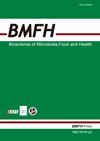Average gut flora in healthy Japanese subjects stratified by age and body mass index
IF 2.9
4区 医学
Q2 Agricultural and Biological Sciences
引用次数: 10
Abstract
Imbalance of the gut microbiota plays an important role in the pathogenesis of various diseases. Although many clinical studies have analyzed the gut microbiota, the definition of normal gut microbiota remains unclear. In this study, we aim to establish the average gut microbiota in the healthy Japanese population. Using 16S ribosomal RNA gene sequencing, we analyzed gut microbial data from fecal samples obtained from 6,101 healthy Japanese individuals. Based on their ages, the individuals were divided into three groups: young, middle-age, and old. Individuals were further categorized according to body mass index (BMI) into lean, normal, and obese groups. The α and β diversities in the old group were significantly higher than those in the young and middle-age groups. The Firmicutes/Bacteroidetes ratio of subjects in the obese category was significantly lower compared with those of subjects in the lean and normal categories in the young and middle-age groups. Genus Bacteroides was the dominant gut microbiota across all the BMI categories in all the age groups. Among the top ten genera, the abundances of Bacteroides, Bifidobacterium, Anaerostipes, Blautia, Dorea, Fusicatenibacter, Lachnoclostridium, and Parabacteroides were significantly lower in the old group than in the young and middle-age groups. The correlation network at the genus level revealed different microbe-microbe interactions associated with age and BMI. We determined the average Japanese gut microbiota, and this information could be used as a reference. The gut microbiota greatly differs based on the life stage and metabolic status of the host, and this gives rise to a variety of host–gut microbe interactions that can lead to an increased susceptibility to disease.日本健康受试者的平均肠道菌群按年龄和体重指数分层
肠道菌群失衡在多种疾病的发病机制中起着重要作用。尽管许多临床研究已经分析了肠道菌群,但正常肠道菌群的定义仍然不清楚。在这项研究中,我们的目标是建立健康的日本人群的平均肠道微生物群。利用16S核糖体RNA基因测序,我们分析了来自6101名健康日本人的粪便样本的肠道微生物数据。根据他们的年龄,这些人被分为三组:年轻人、中年人和老年人。根据身体质量指数(BMI)将个体进一步分为瘦组、正常组和肥胖组。老年组α和β多样性显著高于中青年组。肥胖组的厚壁菌门/拟杆菌门比值明显低于中青年组的瘦弱和正常组。在所有年龄组的所有BMI类别中,拟杆菌属是主要的肠道微生物群。在前10个属中,老年组Bacteroides、Bifidobacterium、Anaerostipes、Blautia、Dorea、Fusicatenibacter、Lachnoclostridium和Parabacteroides的丰度显著低于中青年组。在属水平上的相关网络揭示了不同的微生物-微生物相互作用与年龄和BMI相关。我们测定了日本人的平均肠道菌群,这些信息可以作为参考。根据宿主的生命阶段和代谢状态,肠道微生物群有很大的不同,这就导致了宿主-肠道微生物的各种相互作用,从而导致对疾病的易感性增加。
本文章由计算机程序翻译,如有差异,请以英文原文为准。
求助全文
约1分钟内获得全文
求助全文
来源期刊

Bioscience of Microbiota, Food and Health
Immunology and Microbiology-Applied Microbiology and Biotechnology
CiteScore
5.50
自引率
3.20%
发文量
24
期刊介绍:
Bioscience of Microbiota, Food and Health (BMFH) is a peer-reviewed scientific journal with a specific area of focus: intestinal microbiota of human and animals, lactic acid bacteria (LAB) and food immunology and food function. BMFH contains Full papers, Notes, Reviews and Letters to the editor in all areas dealing with intestinal microbiota, LAB and food immunology and food function. BMFH takes a multidisciplinary approach and focuses on a broad spectrum of issues.
 求助内容:
求助内容: 应助结果提醒方式:
应助结果提醒方式:


